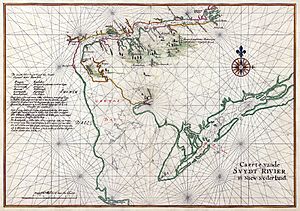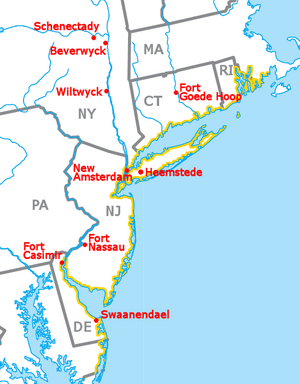Zwaanendael Colony facts for kids
Zwaanendael or Swaanendael (pronounced "zwah-nen-dell") was a short-lived Dutch settlement in what is now Delaware. It was built in 1631. The name is an old Dutch term meaning "swan valley." The area where the settlement once stood is now the town of Lewes, Delaware.
Contents
History of Zwaanendael
Early Land Purchase
In 1629, two leaders from the Amsterdam branch of the Dutch West India Company, Samuel Blommaert and Samuel Godyn, bought a large piece of land from the Native Americans. This land stretched from Cape Henlopen to the mouth of the Delaware River. This was three years before the colony of Maryland was officially started. It was the very first land deed (official ownership document) for land in Delaware.
The purchase was approved in 1630 by Peter Minuit and his council at Fort Amsterdam (which is now New York City). More land was added on May 5, 1630, when a twelve-mile square area (about 31 square kilometers) was bought on the coast of Cape May across the bay.
The First Settlement
The Dutch West India Company was formed to set up a colony on this land. Several important people were involved, including Blommaert, Godyn, Kiliaen van Rensselaer (a large landowner), Joannes de Laet (a geographer), and David Pietersen de Vries.
A ship called The Walvis (The Whale) was prepared. It had eighteen guns to protect the coast and also planned to hunt whales to help pay for the trip. A group of twenty-eight colonists settled on a creek called Blommaert's Kill (now Lewes Creek), just north of Cape Henlopen. Gillis Hosset was put in charge. This settlement was built several years before any in Pennsylvania. The colony at Lewes helped define the small area that became the state of Delaware.
The colonists built a fort with strong wooden walls. The "red lion, rampant" (a symbol of Holland) was placed on its gate. The area was named Swaanendael or Zwaanendael Colony, and the water was called Godyn's Bay (now Delaware Bay).
The Attack and Aftermath
The little colony did not last long. The Native Americans attacked it because of a misunderstanding. The settlement was destroyed, and only two boys, Pierre and Hendrick Wiltsee, survived.
Later, De Vries learned the details of the attack from the Nanticoke Indians. He was told that one of their chiefs had taken a piece of tin with the Dutch symbol on it from a column, not knowing it was wrong. The Dutch leaders were upset, so the Indians, trying to make things right, killed their own chief. But the Dutch leaders said they wished they hadn't done that.
The friends of the killed chief wanted revenge. They waited until most of the Dutch colonists were outside working. Only one sick man and a chained dog were inside the fort. Three strong Native Americans came with bear skins, pretending to trade. The man in charge went inside with them. As he went upstairs, one of the Native Americans hit him with an axe, killing him. They also killed the sick man and shot many arrows into the chained dog before it died. Then they went outside and attacked the other workers, pretending to be friendly before striking them down. This is how the young colony was destroyed.
When De Vries arrived on December 5, 1632, he found only the burned remains of the settlement. He had heard about the attack before leaving Europe. De Vries made a peace treaty with the Native Americans. He then sailed up the Delaware River, trying to trade for food. When that didn't work, he went to Virginia to get supplies for the new colonists he had brought. He returned to Zwaanendael, but the massacre convinced the Dutch to pull back their settlements. Soon after, De Vries moved the new colonists to New Amsterdam (which is now New York City). The land claims for Zwaanendael were then sold back to the Dutch West India Company.
Later, Blommaert helped prepare the first Swedish trip to New Sweden in 1637. He hired Peter Minuit (who was no longer Governor of New Netherland) to lead it.
Another experimental settlement was started on Delaware Bay in 1663. This was just before the British took over the area in 1664. Franciscus van den Enden had created a plan for a perfect society that included equal education for everyone, shared property, and a government chosen by the people. Pieter Corneliszoon Plockhoy tried to build such a settlement near Zwaanendael, but it was mostly destroyed by the British in 1664.
Legacy
A monument called De Vries Palisade was built on September 22, 1909, to remember the colony. It stands on the site of the old settlement. The Zwaanendael Museum opened in 1931, telling the story of the area.



